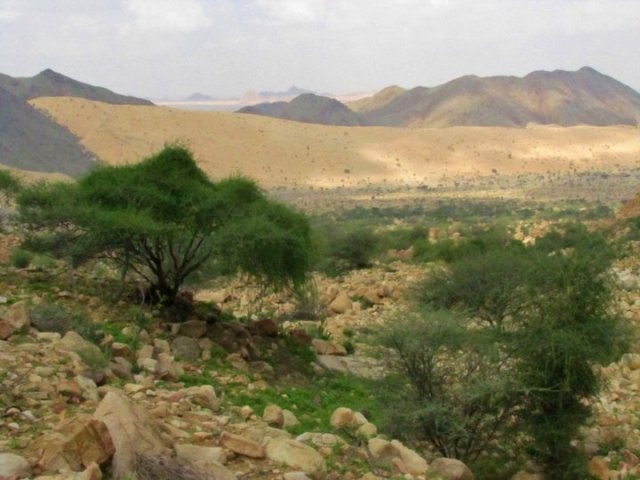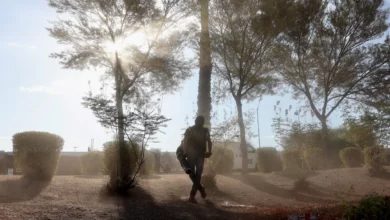
There is a place in Egypt where the mountain blossoms on one side, where sea moisture accumulates on the mountaintop and forms rivulets that trickle down the hill and spur insatiable, rainforest-like vegetation inhabited by the most incredible creatures. There is a giant stretch of land that encompasses a myriad ecosystems, from marshes, coastal plains, mangroves and coral reefs to mountain highlands, sand dunes and valleys.
This place is remote, stretches over 35,600 square kilometers of biodiversity-laden land and is an ordeal to access. This “Garden of Eden,” hidden from most eyes, is Gebel Elba, the country’s largest and richest protected area.
The national park stretches from 50 kilometers north of Shalateen all the way south to the Sudanese border and includes dozens of islands that sprinkle the 250-kilometer-long maritime coast. It extends westward roughly 100 kilometers into the Eastern Desert.
A 25-kilometer-wide coastal plain separates the Red Sea coast from the southernmost mountains of Egypt, which include Gebel Elba — which reaches 1,435 meters — Gebel Shellal, Gebel Shendib and Gebel Shendodai.
On the other side of the highlands, deep into the Eastern Desert, lie desert valleys, sand plains and Red Sea hills, and a network of small and deep valleys, or wadis, such as Wadi Akwamtra, Wadi Adeib and Wadi Serimtai. They have been formed in the mountains that flow to the Red Sea and the Nile Valley.

Usama Ghazali, head ranger of Gebel Elba National Park, gave a presentation on Gebel Elba a week ago in front of a packed audience at the Nahdet El Mahrousa NGO office downtown, under the auspices of Nature Conservation Egypt, one of the country’s leading conservation organizations.
Ghazali described the park’s splendid features and highlighted some of the threats Gebel Elba is currently facing, including climate change and underdevelopment.
He says that although Gebel Elba was declared a national park in 1986, thanks to the lobbying work of conservationists and scientists, the Environment Ministry has shown a continuous lack of interest in the park, despite its legal status.
The ranger, who earlier this year won a conservation prize for his work to preserve the park, says that to this day, Gebel Elba’s only infrastructure is a visitors’ center at the park entrance, and the annual budget allocated to park management and rangers does not exceed a few thousand pounds.
“We only have three cars to survey 35,600 square kilometers. This is absolutely insufficient. Budgets for parks should be allocated by taking into consideration the flora and fauna wealth, and should evaluate the resources needed for each park.”
Gebel Elba’s various ecosystems host a thriving biodiversity, with 458 plant species that include acacias, moringas and dragon trees; 86 different corals; 104 fish species; 60 resident birds comprising vultures, eagles and falcons; 26 mammals, including gazelles, Barbary sheep and ibexes; and 38 reptile and amphibian species that account for 35 percent of Egypt’s herpetofauna (reptiles and amphibians of a particular region).
One of the park’s most endangered species is the dragon tree, or Dracaena ombet, a 10-meter-high tree with curved, spiky leaves that gather rain drops and deliver most of the tree’s hydration. The top forms a thick green canopy, and its fibrous wood — not suitable for making firewood or charcoal — has enabled its survival to this date.
Although human activities are not directly to blame for the reduction in these trees, it seems that climate change and higher temperatures have taken a toll, and numbers have continuously diminished for 20 years, according to Ghazali.
In 2007 and 2009, he and a team of eight rangers from various protectorates received two grants from the Conservation Leadership Programme, an international partnership of four organizations working to promote the development of future biodiversity conservation leaders, to survey and assess the Gebel Elba dragon tree population.
“The dragon tree population has decreased by 65 percent for the past 20 to 25 years,” Ghazali says, “and our prediction for 2017 is that we will lose over 85 percent of them.”
Since this tree gets most of its water input from its leaves, whose cupped shape facilitates the transfer of rainwater to the tree, the gradual decrease in precipitation for the past 20 years has greatly affected tree numbers.
“When we talk about climate change in Egypt, we limit its impact to the northern cities and the Delta. But its impact can be felt in Gebel Elba very accurately as well,” Ghazali says.
The area’s high amount of moisture comes from its closeness to the sea, and its favorable position in the face of humid northeasterly winds. Precipitations used to be continuous and strong in the fall, and the area would enjoy an average rainfall of 400 millimeters each year.
But this has changed, says Ghazali, who has noticed not only a decrease in the dragon tree population and quality, but also the fact that the trees now grow higher on the mountain slope, thirsty for the infrequent rainfalls.
“I use the dragon tree as a biological indicator for climate change, which also acts as a whistleblower for the entire biodiversity’s well-being,” says Ghazali, who has been following this endangered species since the mid-1990s.

The other threat to the dragon tree’s existence is the fast and rampant invasion of the mesquite tree. Its ability to resist drought and its rapid spread have enabled it to nibble away at the dragon tree’s space and reach water deep below the ground.
“Until 1996, the mesquite tree was a domestic plant that was introduced by the local community in the village of Halayeb on the coast,” explains Ghazali, who says the tree came from Sudan. “But since the precipitation is becoming irregular and drought has become the norm, the mesquite started spreading and now covers an area of 8,000 square kilometers. The seeds are chomped on by camels and deposited in the excrement in faraway locations, and the mesquite now competes with the dragon tree.
He says he fears that if no drastic measures are taken to remove the mesquite trees, they could replace the native dragon trees in 10 years. He launched a campaign through his small, local NGO to encourage locals to cut down the invasive tree, and has distributed seedlings of native species to encourage people to grow them instead.
One message Ghazali hopes to spread is that the great ecotourism potential of Gebel Elba is completely disregarded by authorities. He says the park needs more infrastructure, such as better roads from Marsa Alam to bring in tourists. He would also like to build lodging for visitors.
But none of this can be achieved without substantial help from the Environment Ministry, he says, and the removal of travel restrictions imposed by the military on Egyptians and foreigners alike.
This piece was originally published in Egypt Independent's weekly print edition.




